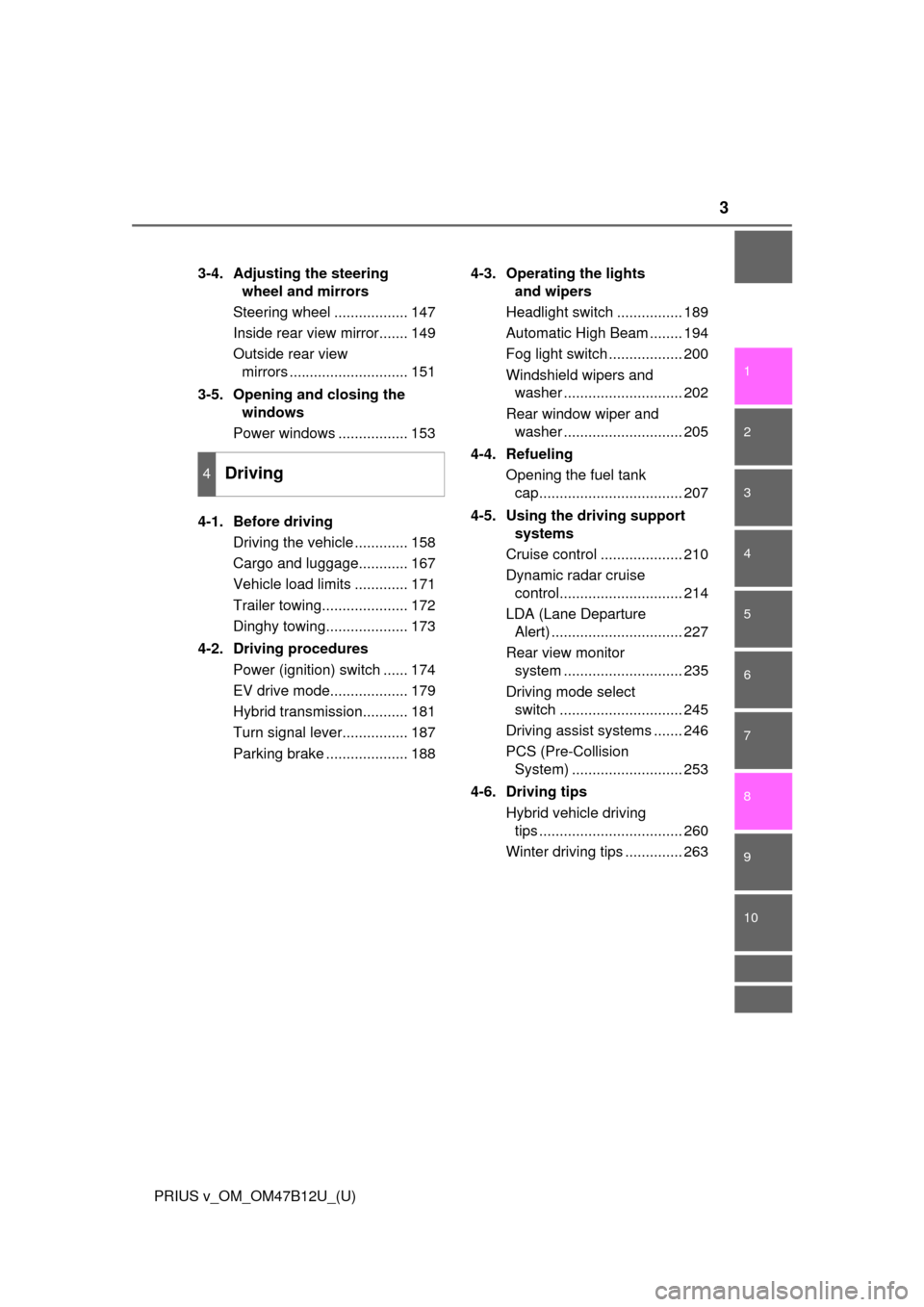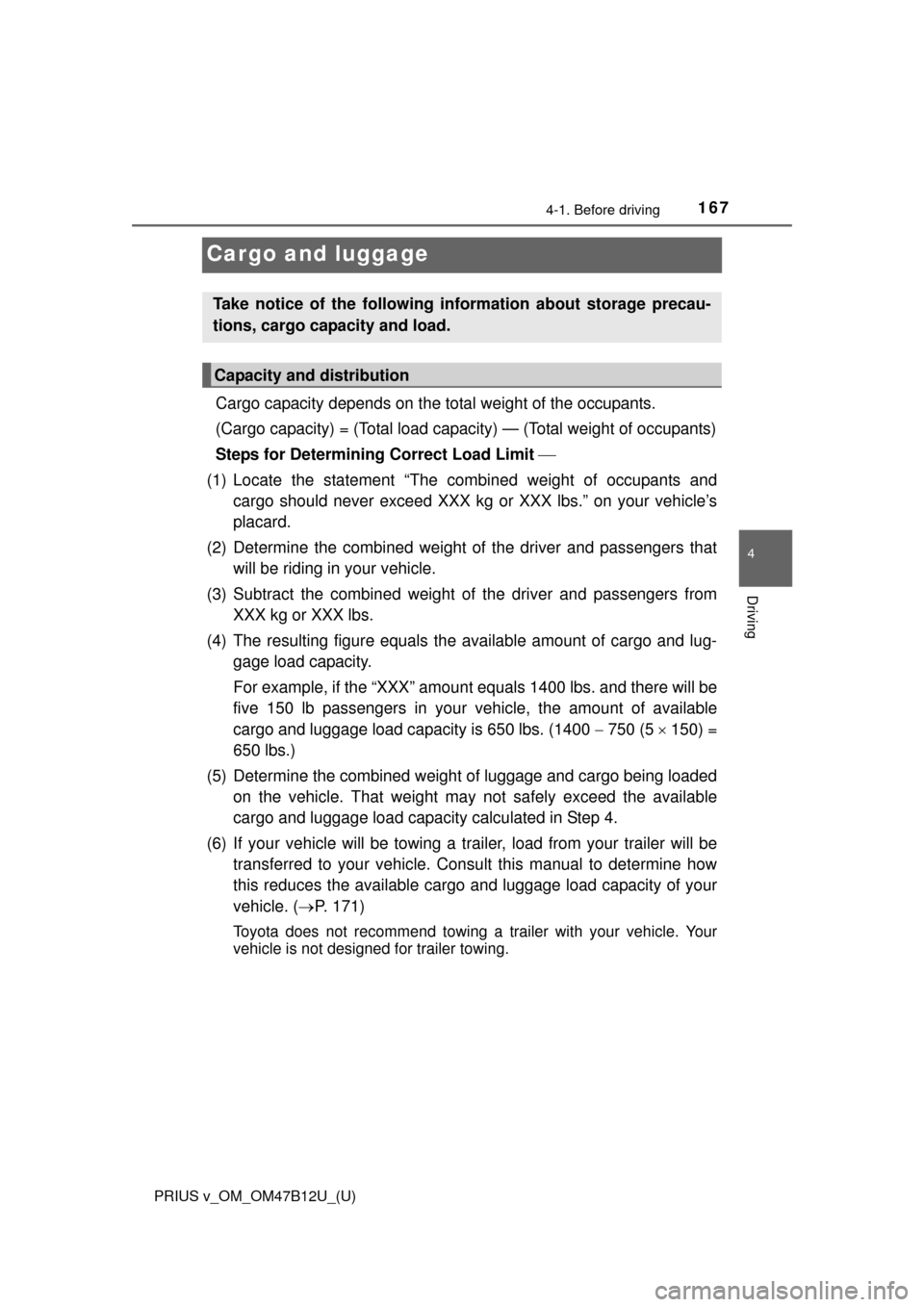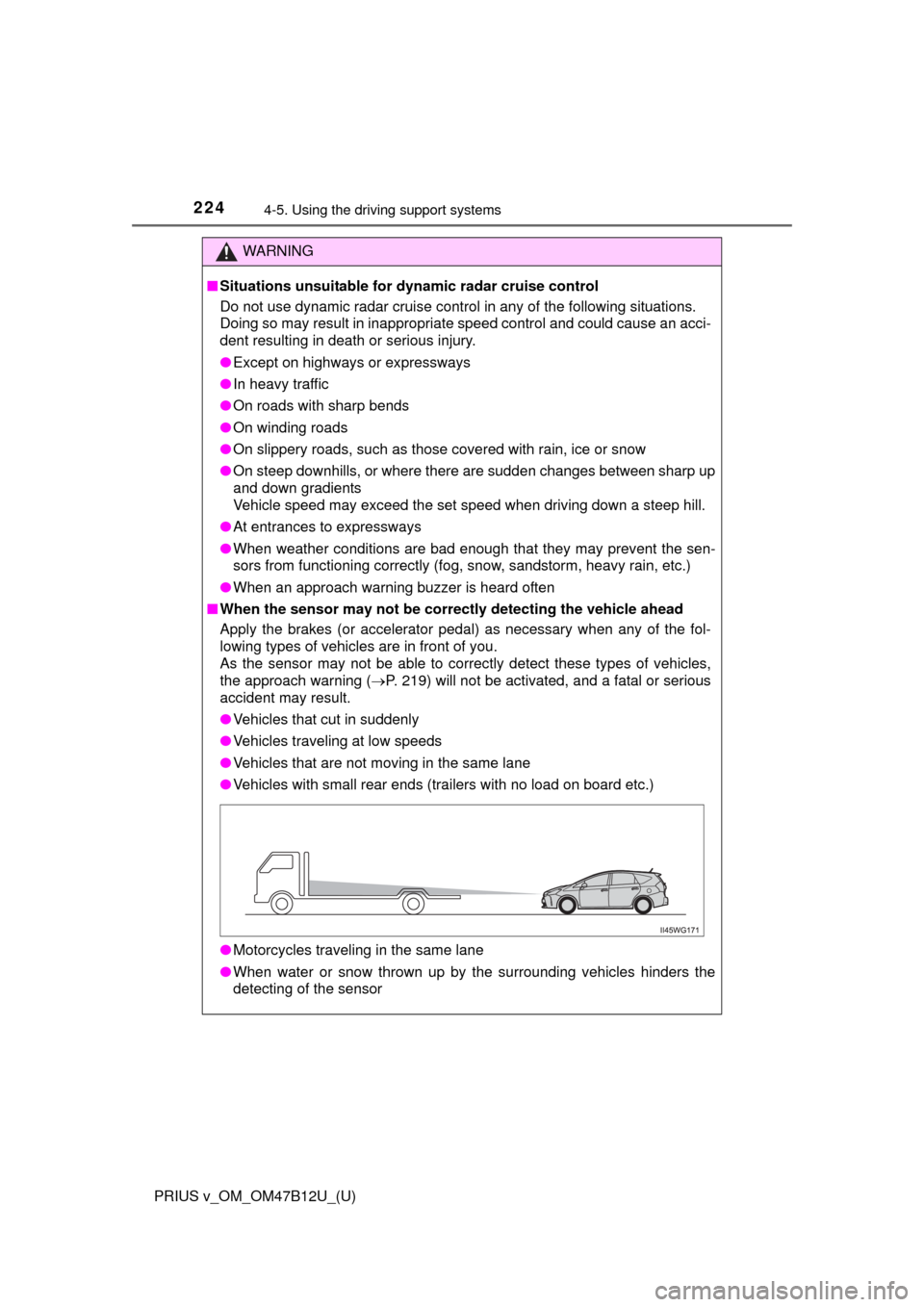2016 TOYOTA PRIUS V trailer
[x] Cancel search: trailerPage 3 of 620

3
1
9 8
7
6 4 3
2
PRIUS v_OM_OM47B12U_(U)
10
5
3-4. Adjusting the steering
wheel and mirrors
Steering wheel .................. 147
Inside rear view mirror....... 149
Outside rear view
mirrors ............................. 151
3-5. Opening and closing the
windows
Power windows ................. 153
4-1. Before driving
Driving the vehicle ............. 158
Cargo and luggage............ 167
Vehicle load limits ............. 171
Trailer towing..................... 172
Dinghy towing.................... 173
4-2. Driving procedures
Power (ignition) switch ...... 174
EV drive mode................... 179
Hybrid transmission........... 181
Turn signal lever................ 187
Parking brake .................... 1884-3. Operating the lights
and wipers
Headlight switch ................ 189
Automatic High Beam ........ 194
Fog light switch .................. 200
Windshield wipers and
washer ............................. 202
Rear window wiper and
washer ............................. 205
4-4. Refueling
Opening the fuel tank
cap................................... 207
4-5. Using the driving support
systems
Cruise control .................... 210
Dynamic radar cruise
control.............................. 214
LDA (Lane Departure
Alert) ................................ 227
Rear view monitor
system ............................. 235
Driving mode select
switch .............................. 245
Driving assist systems ....... 246
PCS (Pre-Collision
System) ........................... 253
4-6. Driving tips
Hybrid vehicle driving
tips ................................... 260
Winter driving tips .............. 263
4Driving
Page 157 of 620

157
PRIUS v_OM_OM47B12U_(U)
4Driving
4-1. Before driving
Driving the vehicle ............. 158
Cargo and luggage ........... 167
Vehicle load limits ............. 171
Trailer towing..................... 172
Dinghy towing ................... 173
4-2. Driving procedures
Power (ignition) switch ...... 174
EV drive mode .................. 179
Hybrid transmission........... 181
Turn signal lever................ 187
Parking brake .................... 188
4-3. Operating the lights
and wipers
Headlight switch ................ 189
Automatic High Beam ....... 194
Fog light switch ................. 200
Windshield wipers and
washer ............................ 202
Rear window wiper and
washer ............................ 2054-4. Refueling
Opening the fuel tank
cap .................................. 207
4-5. Using the driving support
systems
Cruise control .................... 210
Dynamic radar cruise
control ............................. 214
LDA (Lane Departure
Alert) ............................... 227
Rear view monitor
system ............................ 235
Driving mode select
switch .............................. 245
Driving assist systems ...... 246
PCS (Pre-Collision
System)........................... 253
4-6. Driving tips
Hybrid vehicle driving
tips .................................. 260
Winter driving tips ............. 263
Page 167 of 620

167
PRIUS v_OM_OM47B12U_(U)
4-1. Before driving
4
Driving
Cargo and luggage
Cargo capacity depends on the total weight of the occupants.
(Cargo capacity) = (Total load capacity) — (Total weight of occupants)
Steps for Determining Correct Load Limit
(1) Locate the statement “The combined weight of occupants and
cargo should never exceed XXX kg or XXX lbs.” on your vehicle’s
placard.
(2) Determine the combined weight of the driver and passengers that
will be riding in your vehicle.
(3) Subtract the combined weight of the driver and passengers from
XXX kg or XXX lbs.
(4) The resulting figure equals the available amount of cargo and lug-
gage load capacity.
For example, if the “XXX” amount equals 1400 lbs. and there will be
five 150 lb passengers in your vehicle, the amount of available
cargo and luggage load capacity is 650 lbs. (1400 750 (5150) =
650 lbs.)
(5) Determine the combined weight of luggage and cargo being loaded
on the vehicle. That weight may not safely exceed the available
cargo and luggage load capacity calculated in Step 4.
(6) If your vehicle will be towing a trailer, load from your trailer will be
transferred to your vehicle. Consult this manual to determine how
this reduces the available cargo and luggage load capacity of your
vehicle. (P. 171)
Toyota does not recommend towing a trailer with your vehicle. Your
vehicle is not designed for trailer towing.
Take notice of the following information about storage precau-
tions, cargo capacity and load.
Capacity and distribution
Page 171 of 620

171
PRIUS v_OM_OM47B12U_(U)
4-1. Before driving
4
Driving
Vehicle load limits
◆Total load capacity (vehicle capacity weight): P. 5 5 2
Total load capacity means the combined weight of occupants, cargo
and luggage.
◆Seating capacity: 5 occupants (Front 2, Rear 3)
Seating capacity means the maximum number of occupants whose
estimated average weight is 150 lb. (68 kg) per person.
◆Towing capacity
Toyota does not recommend towing a trailer with your vehicle.
◆Cargo capacity
Cargo capacity may increase or decrease depending on the weight
and the number of occupants.
■Total load capacity and seating capacity
These details are also described on the tire and loading information label.
(P. 452)
Vehicle load limits include total load capacity, seating capacity,
towing capacity and cargo capacity.
WARNING
■Overloading the vehicle
Do not overload the vehicle.
It may not only cause damage to the tires, but also degrade steering
and braking ability, resulting in an accident.
Page 172 of 620

172
PRIUS v_OM_OM47B12U_(U)
4-1. Before driving
Trailer towing
Toyota does not recommend towing a trailer with your vehicle.
Toyota also does not recommend the installation of a tow hitch
or the use of a tow hitch carrier for a wheelchair, scooter, bicy-
cle, etc. Your vehicle is not designed for trailer towing or for the
use of tow hitch mounted carriers.
Page 198 of 620

198
PRIUS v_OM_OM47B12U_(U)
4-3. Operating the lights and wipers
●In the situations below, the system may not be able to correctly detect the
surrounding brightness levels, and may flash or expose nearby pedestrians
to the high beam. Therefore, you should consider turning the high beams on
or off manually rather than relying on the Automatic High Beam system.
• In bad weather (rain, snow, fog, sandstorms etc.)
• The windshield is obscured by fog, mist, ice, dirt etc.
• The windshield is cracked or damaged.
• The camera sensor is deformed or dirty.
• The camera sensor temperature is extremely high.
• Surrounding brightness levels are equal to those of headlights, tail lights
or fog lights.
• Vehicles ahead have headlights that are either switched off, dirty, are
changing color, or have are not aimed properly.
• When driving through an area of intermittently changing brightness and
darkness.
• When frequently and repeatedly driving ascending/descending roads, or
roads with rough, bumpy or uneven surfaces (such as stone-paved
roads, gravel tracks etc.).
• When frequently and repeatedly taking curves or driving on a winding
road.
• There is a highly reflective object ahead of the vehicle, such as a sign or
a mirror.
• The back of a vehicle ahead is highly reflective, such as a container on a
truck.
• The vehicle’s headlights are damaged or dirty.
• The vehicle is listing or tilting, due to a flat tire, a trailer being towed etc.
• The high beam and low beam are repeatedly being switched between in
an abnormal manner.
• The driver believes that the high beam may be causing problems or dis-
tress to other drivers or pedestrians nearby.
WARNING
■Limitations of the Automatic High Beam
Do not rely on the Automatic High Beam. Always drive safely, taking care to
observe your surroundings and turning high beam on or off manually if nec-
essary.
Page 224 of 620

224
PRIUS v_OM_OM47B12U_(U)
4-5. Using the driving support systems
WARNING
■Situations unsuitable for dynamic radar cruise control
Do not use dynamic radar cruise control in any of the following situations.
Doing so may result in inappropriate speed control and could cause an acci-
dent resulting in death or serious injury.
●Except on highways or expressways
●In heavy traffic
●On roads with sharp bends
●On winding roads
●On slippery roads, such as those covered with rain, ice or snow
●On steep downhills, or where there are sudden changes between sharp up
and down gradients
Vehicle speed may exceed the set speed when driving down a steep hill.
●At entrances to expressways
●When weather conditions are bad enough that they may prevent the sen-
sors from functioning correctly (fog, snow, sandstorm, heavy rain, etc.)
●When an approach warning buzzer is heard often
■When the sensor may not be correctly detecting the vehicle ahead
Apply the brakes (or accelerator pedal) as necessary when any of the fol-
lowing types of vehicles are in front of you.
As the sensor may not be able to correctly detect these types of vehicles,
the approach warning (P. 219) will not be activated, and a fatal or serious
accident may result.
●Vehicles that cut in suddenly
●Vehicles traveling at low speeds
●Vehicles that are not moving in the same lane
●Vehicles with small rear ends (trailers with no load on board etc.)
●Motorcycles traveling in the same lane
●When water or snow thrown up by the surrounding vehicles hinders the
detecting of the sensor
Page 617 of 620

617Alphabetical index
PRIUS v_OM_OM47B12U_(U)
Tail lights
Light switch ........................... 189
Replacing light bulbs............. 478
Talk switch ............................... 337
Telephone switch .................... 337
Theft deterrent system
Immobilizer system................. 82
Tire inflation pressure
Maintenance data ................. 559
Warning light ......................... 495
Tire pressure warning system
Function ................................ 444
Initializing .............................. 444
Installing tire pressure
warning valves and
transmitters......................... 444
Registering ID codes ............ 445
Tire pressure warning
reset switch ........................ 445
Warning light ......................... 495
Tire information ....................... 564Tires .......................................... 443
Chains .................................. 264
Checking............................... 443
Glossary ............................... 569
If you have a flat tire ............. 521
Inflation pressure .................. 452
Replacing.............................. 521
Rotating tires ........................ 443
Size....................................... 559
Snow tires ............................. 263
Spare tire ...................... 521, 559
Tire identification number ..... 566
Tire pressure warning
system ................................ 444
Uniform Tire Quality
Grading .............................. 567
Warning light......................... 495
Tools ......................................... 522
Top tether strap ......................... 69
Total load capacity .................. 552
Towing
Dinghy towing ....................... 173
Emergency towing ................ 484
Towing eyelet ....................... 486
Trailer towing ........................ 172
Traction control ....................... 246
Trailer towing ........................... 172
Transmission
Driving mode select switch ... 245
Hybrid transmission .............. 181
P position switch ................... 182
Selecting a driving mode ...... 245
T